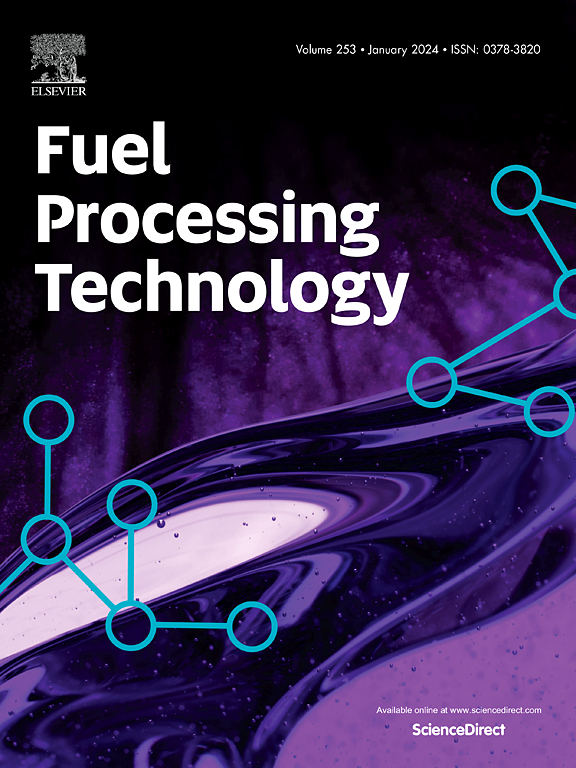利用光谱制导研究生物质共烧过程中氨对非灰辐射和温度测量的影响
IF 7.7
2区 工程技术
Q1 CHEMISTRY, APPLIED
引用次数: 0
摘要
氨与生物质共烧是脱碳发电的重要策略,但优化其效率和排放需要精确的火焰温度监测。然而,可靠的诊断受到强烈的、相位依赖的非灰辐射(挥发性与焦化)和NH3对基本光谱辐射特性的严重无法量化的影响的阻碍。利用同步光谱法和RGB热释光法,系统地研究了NH3浓度对燃烧稻壳颗粒在可见光光谱(400-700 nm)内不同挥发相和焦炭燃烧阶段光谱发射率ε(λ)的影响。研究表明,NH3显著降低了两种挥发性燃烧的ε(λ),其中ελ随波长(ε(λ) <)而减小;ε(λ)≈0.35 ~ 0.75,ελ随波长增大而增大。因此,RGB热法所需的关键发射比εg/εr(在530/600 nm处)表现出相反的行为:挥发性燃烧时,εg/εr >;随着NH3浓度的增加,εg/εr <;1,随NH3浓度的增加而降低。在这些定量发现的基础上,开发和验证的光谱引导RGB热分析法成功地纠正了灰体假设中固有的大量温度高估,这一错误在较高的NH3浓度下尤其明显。这项工作提供了关于氨对生物质非灰辐射影响的基本定量数据和强大的光谱引导诊断方法,为实现生物质-氨共烧过程的精确建模、优化和控制提供了必要的数据和技术。本文章由计算机程序翻译,如有差异,请以英文原文为准。
Elucidating ammonia's impact on non-gray radiation and thermometry during biomass co-firing via spectral guidance
Ammonia co-firing with biomass is a vital strategy for decarbonizing power generation, yet optimizing its efficiency and emissions necessitates accurate flame temperature monitoring. Reliable diagnosis, however, is impeded by strong, phase-dependent non-gray radiation from biomass (volatile vs. char) and the critically unquantified impact of NH3 on essential spectral radiative properties. This work systematically investigates the influence of NH3 concentration on the spectral emissivity ε(λ) of burning rice husk particles within the visible spectrum (400–700 nm) during distinct volatile and char combustion phases, utilizing simultaneous spectroscopy and RGB pyrometry. The investigation revealed that NH3 significantly lowers ε(λ) for both volatile combustion, where ελ decreases with wavelength (ε(λ) < 0.16), and char combustion, where ελ increases with wavelength (ε(λ) ≈ 0.35–0.75). Consequently, the key emissivity ratio εg/εr (at 530/600 nm) required for RGB pyrometry exhibited opposite behaviors: for volatile combustion, εg/εr > 1 and increased with NH3 concentration, whereas for char combustion, εg/εr < 1 and decreased with NH3 concentration. Building upon these quantitative findings, the developed and validated spectrally-guided RGB pyrometry methodology successfully corrects the substantial temperature overestimation inherent in the gray-body assumption, an error particularly pronounced at higher NH3 concentrations. This work yields both fundamental quantitative data on ammonia's impact on biomass non-gray radiation and a robust spectrally-guided diagnostic method, providing essential data and techniques for enabling accurate modeling, optimization, and control of biomass-ammonia co-firing processes.
求助全文
通过发布文献求助,成功后即可免费获取论文全文。
去求助
来源期刊

Fuel Processing Technology
工程技术-工程:化工
CiteScore
13.20
自引率
9.30%
发文量
398
审稿时长
26 days
期刊介绍:
Fuel Processing Technology (FPT) deals with the scientific and technological aspects of converting fossil and renewable resources to clean fuels, value-added chemicals, fuel-related advanced carbon materials and by-products. In addition to the traditional non-nuclear fossil fuels, biomass and wastes, papers on the integration of renewables such as solar and wind energy and energy storage into the fuel processing processes, as well as papers on the production and conversion of non-carbon-containing fuels such as hydrogen and ammonia, are also welcome. While chemical conversion is emphasized, papers on advanced physical conversion processes are also considered for publication in FPT. Papers on the fundamental aspects of fuel structure and properties will also be considered.
 求助内容:
求助内容: 应助结果提醒方式:
应助结果提醒方式:


